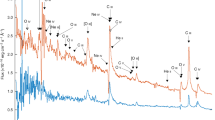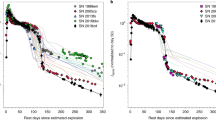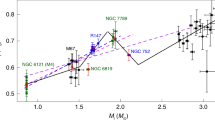Abstract
The immediate progenitor of a Type I supernova (SN I) is thought to be a mass-accreting carbon–oxygen (C–O) white dwarf in a binary system. When the mass of the white dwarf approaches the Chandrasekhar mass (1.4 M⊙) the C–O nuclear fuel ignites, part of the star is incinerated to radioactive 56Ni, and the thermonuclear energy completely disrupts the star. The optical luminosity results from the trapping and thermalization of the γ rays and positrons emitted by the decay of 56Ni through 56Co to stable 56Fe. The amount of 56Ni synthesized, MNi, and the corresponding peak luminosity, Lmax, can be used with the observed Hubble diagram for SN I to determine the value of Hubble's constant, H0. We argue here that if this model is correct, MNi is in the range 0.4–1.4 M⊙, the best estimate being 0.6 M⊙, and that H0 is in the range 39–73 km s−1 Mpc−1 with a best estimate of 59 km s−1 Mpc−1. This line of reasoning does not require knowledge of the temperature of the supernova and, therefore, is not subject to the uncertainties associated with attempts to determine supernova luminosities and distances by the Baade method1. It relies on the physical correctness of the model, which is subject to independent tests.
This is a preview of subscription content, access via your institution
Access options
Subscribe to this journal
Receive 51 print issues and online access
$199.00 per year
only $3.90 per issue
Buy this article
- Purchase on Springer Link
- Instant access to full article PDF
Prices may be subject to local taxes which are calculated during checkout
Similar content being viewed by others
References
Wagoner, R. V. Astrophys. J. 250, L65–L69 (1981).
Arnett, W. D. Astrophys. J. 253, 785–797 (1982).
Sutherland, P. G. and Wheeler, J. C. Astrophys. J. 280, 282–297 (1984).
Barbon, R., Ciatti, F. & Rosino, L. Astr. Astrophys. 25, 241–248 (1973).
Branch, D. et al. Astrophys. J. 270, 123–139 (1983).
Müller, E. & Arnett, W. D. Astrophys. J. Lett. 261, L109–L115 (1982).
Müller, E. & Arnett, W. D. in Nucleosynthesis: Problems and Challenges (eds Arnett, W. D. & Truran, J. W.) (University of Chicago, in the press).
Nomoto, K., Thielmann, F.-K. & Yokoi, K. Astrophys. J. 268, 644–658 (1984).
Woosley, S. E., Axelrod, T. S. & Weaver, T. A. in Stellar Nucleosynthesis (eds Chiosi, C. & Renzini, A.) (Reidel, Dordrecht, 1984).
Schurmann, S. R. Astrophys. J. 267, 779–794 (1983).
Burstein, D. & Heiles, C. Astrophys. J. 225, 40–55 (1978).
Branch, D. & Bettis, C. Astr. J. 83, 224–227 (1978).
Tammann, G. A. in Supernovae: A Survey of Current Research (eds Rees, M. J. & Stoneham, R. J.) 371–403 (Reidel, Dordrecht, 1982).
Helfand, D. J. in Type I Supernovae (ed. Wheeler, J. C.) 20–24 (University of Texas, Austin, 1980).
Nomoto, K. & Tsuruta, S. Astrophys. J. Lett. 250, L19–L23 (1981).
Rust, B. W. thesis, Univ. Illinois, Urbana (1974).
Pskovskii, Y. P. Soviet Astr.-A. J. 21, 675–682 (1977).
Branch, D. Astrophys. J. 258, 35 (1982).
Author information
Authors and Affiliations
Rights and permissions
About this article
Cite this article
Arnett, W., Branch, D. & Wheeler, J. Hubble's constant and exploding carbon–oxygen white dwarf models for Type I supernovae. Nature 314, 337–338 (1985). https://doi.org/10.1038/314337a0
Received:
Accepted:
Issue Date:
DOI: https://doi.org/10.1038/314337a0
This article is cited by
-
Supernovae and cosmology
General Relativity and Gravitation (2008)
-
The type Ia supernova SNLS-03D3bb from a super-Chandrasekhar-mass white dwarf star
Nature (2006)
Comments
By submitting a comment you agree to abide by our Terms and Community Guidelines. If you find something abusive or that does not comply with our terms or guidelines please flag it as inappropriate.



